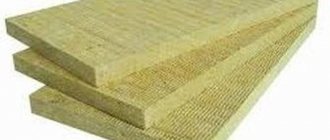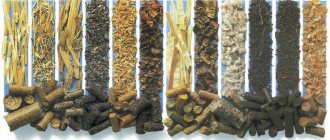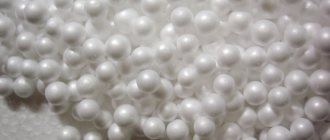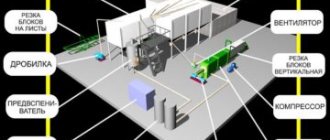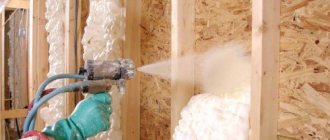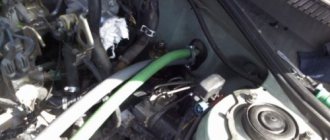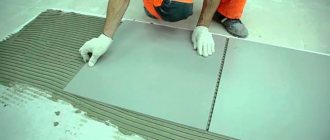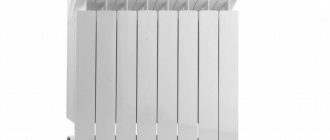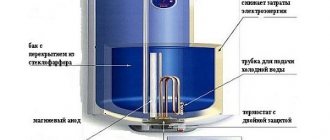| Name | Key Features |
| Liquid | The most common. It is used for thermal insulation of various structures and for repairs. Fills cracks and gaps. Can be prepared at a construction site. |
| Granular (thermal wool) | It is made by crushing the polymer into fractions of 10-15 mm. Economical during installation. Penoizol in granules in volume is 2 times greater than the amount of sheet polymer obtained during production. It is used to fill cavities between walls when laying floors. |
| Sheet | The insulation is poured into a special mold, cut, dried and further processed when ready. It is mounted on the outside of the walls of houses, secured with dowels. It can also be laid on the floor (between joists). |
Indicators and advantages of penoizol
The popularity of urea foam is explained by its low price and characteristics:
- Low thermal conductivity (0.041 W/m2*K). To ensure good thermal insulation, a thin layer of foam insulation is sufficient (minimum 10 cm).
- High noise absorption reaching 65%. Even a narrow layer of building material solves the issue of sound insulation.
- Good fire resistance. The insulation belongs to the G-1 flammability group with the B-2 flammability category. The polymer does not melt, but evaporates without releasing harmful toxins. Smokes weakly.
- Hygroscopicity. Air can pass through the foam; the vapor permeability property allows the walls to “breathe.”
- Chemical neutrality towards various components, including organic solvents.
- Biostability. Fungus and mold do not grow on penoizol, and mice/rats do not gnaw it.
installation of gas and foam generator
- The first thing we will look at in the video instructions is a schematic diagram of the technology and drawings of equipment for the production of urea foam (penoizol and its analogues).
- I will tell you about important technical nuances, mistakes or misunderstandings of unscrupulous manufacturers, including those who may call their urea foam plastic foam insulation
. What you absolutely cannot save on. - From many years of experience, I will demonstrate the design of a simple, but reliable and efficient foam generator; visual photos, videos, diagrams, drawings and instructions will help you easily make such a device with your own hands. My foam generator is easy and quick to maintain and clean if necessary. If it gets clogged, you can disassemble and reassemble it in 10 minutes!
- How to make simple and reliable dispensers for accurate supply of solution and quick adjustment of the amount of resin for the production of foam plastic of different densities and characteristics.
- Required installation maintenance.
Visual demonstration of equipment operation in an open facility. Floor insulation.
Flaws
Penoizol has the following disadvantages.
Firstly, it absorbs moisture and does not release it. Penoizol is quite resistant to moisture, but this feature does not allow the use of insulation when screeding the foundation.
Secondly, the material produces sediment in the range of 0.1-5%.
Thirdly, penoizol breaks easily - it has low tensile strength.
Fourthly, insulation can only be installed at above-zero temperatures (at least +5°C). Only in this case will you get high-quality foam for filling cavities.
If sheet and granular penoizol does not emit hazardous substances, then in liquid form it can evaporate harmful toxins. It is better for workers to have protective equipment.
Stages of production technology for sheet foam insulation
- Preparation of forms.
- Pouring liquid penoizol.
- Exposure 2-3 hours.
- Dismantling the molds and holding the “cubes” of material for 3 hours.
- Primary cutting into sheets.
- Drying.
- Finishing, packaging, warehousing, shipping.
It would seem that everything is simple and clear. However, the production of sheet penoizol is a more complex technology than on-site pouring, requiring careful adherence to the consumption of components, temperature conditions and drying conditions.
Approximate consumption rate of penoizol components for filling a mold with a volume of 1 m3
- Urea-formaldehyde resin – 22 kg.
- Foaming agent – 0.2 kg.
- Curing catalyst (orthophosphoric acid) – 0.3 kg.
- Tap or process water - empirically.
The first thing you need to start producing sheet penoizol is a suitable room. If industrial production volumes are planned, a room with an area of 250-500 m2 will be required, which should accommodate the following production areas:
- Raw materials warehouse.
- Mold filling area.
- Drying area.
- Preliminary and finishing cutting and packaging area.
- Finished goods warehouse.
Features of the production process
To implement the technological process (pouring, disassembling molds, cutting, laying on racks, cutting to size, packaging, etc.) a staff of three people will be required.
In addition, the production premises must be “warm”. Special temperature requirements apply to the drying area. So, in the pouring area the temperature must be maintained at least 15 degrees Celsius, and in the drying area at least 20-28 degrees Celsius.
Since the drying process takes place over three days, the temperature in the drying compartment should rise gradually, starting from 20 degrees on the first day and reaching 28 degrees on the last day. There must be effective supply and exhaust ventilation in the pouring and drying areas.
When drying on racks, finished penoizol slabs should not have “closed” zones. That is, air access is provided from all sides of the slabs. High-quality drying is necessary so that shrinkage does not appear later, and the smell of formaldehyde completely disappears. Its duration depends on the air temperature in the room, relative humidity, the degree of air exchange and the amount of water spent on the production of penoizol.
Molds for pouring slabs consist of four walls made of galvanized steel, connected to each other by means of quickly dismountable locks. The bottom of the mold is a pallet on which a sheet of galvanized steel is placed, after which the walls are installed on it. The inside of the mold is not lubricated with anything.
Penoizol has one drawback - during intensive drying, shrinkage is possible, so initially the “cube” of the finished material is cut into sheets of larger sizes than required. And after final drying, each sheet is passed through a special cutter, adjusted “to size”, which removes “tolerances” (excesses) with an accuracy of up to one millimeter.
Thus, from the initial block, approximately 7 sheets with dimensions of 1200x600x100 millimeters are obtained - 0.5 m3 of finished insulation, which are packed in thermal film in packs of 7 pieces.
Scraps and other residues generated during the cutting and production of foam insulation sheets are crushed into crumbs, packaged in bags and used for thermal insulation backfill. That is, we can characterize the production of sheet penoizol. How completely waste-free.
It should be noted that if liquid penoizol can be used, including in the repair and reconstruction of buildings and structures, then sheet material is used mainly in the construction of new buildings.
Penoizol manufacturing technology
- In a separate container, mix 3 ingredients: water, a foaming agent and a reaction catalyst. Urea-formaldehyde resin is poured into the second container. Subsequently, it enters the mixture under the influence of compressed air.
- The components are thoroughly mixed until a mixture is formed that is similar in consistency to a soufflé. The resulting material is called liquid foam insulation, which means it is already suitable for use on construction sites.
- The liquid mass is poured into molds of different sizes. Hardening takes place at room temperature, lasts up to 3 hours (depending on the shape, size and specific recipe), on average - 30-40 minutes.
- The resulting insulation sheets are cut into separate slabs in accordance with the required dimensions.
- Urea foam is coated with a protective compound that increases strength and fire resistance.
- The finished product is packaged and stored.
Technical features of equipment for the production of penoizol
Important components of any penoizol equipment are:
- ease of assembly before starting work and ease of operation,
- productivity level (5 - 30 m3/h);
- quality of mixing components;
- the ability to regulate parameters (dosing and ratio of components, power level of the installation and air pressure in the system, density of the finished penoizol, etc.);
- power consumption and power source (220 or 380V);
- compactness, mobility and light weight of the equipment;
- amount of compressed air consumption (250 - 500 l/min);
- wear resistance.
What you need to get started
A penoizol manufacturing business can be started without major investment. The equipment is inexpensive, and the main expenses each month will be spent on purchasing raw materials and paying staff.
Table 1. The amount of initial costs for the penoizol production business.
| Expense item | price, rub. |
| Registration | 20 thousand |
| Premises for rent, 90 sq. m | 25 thousand |
| Equipment | 200 thousand |
| Raw materials (for a month at full load) | 230 thousand |
| Salary, 6 people. | 190 thousand |
| Additional expenses | 100 thousand |
| Total | 765 thousand |
The calculations are relevant for a city with a population of up to 1-1.5 million people. Additional costs include the costs of utility bills, advertising promotion, premises preparation, etc. The amount of tax deductions is not taken into account in the calculation.
Advantages and disadvantages
Externally, penoizol looks like marshmallow cookies. Pleasant to the touch, lightweight porous white material retains elasticity and strength for several decades. Construction experts note the following advantages of the material:
- Low thermal conductivity coefficient. This indicator puts penoizol among the best insulation materials on the market.
- High adhesion to most building materials and excellent foam penetration. These factors make it easier to apply insulation both over large areas and in various hard-to-reach places, including hidden cavities in walls and roofs. The material fits well on horizontal, vertical and inclined surfaces.
- The estimated service life is 55-75 years. The result was obtained by calculations and large-scale tests, but the analysis of control samples that served for 10-20 years confirms it.
- High vapor permeability. This property allows the insulation to “breathe”, removing excess moisture from its volume. This prevents the accumulation of moisture - a breeding ground for mold and pathogenic microorganisms. At the same time, a comfortable microclimate is maintained in the premises.
- Unattractive to pests: insects and rodents. Penoizol becomes a natural barrier to their spread.
- Resistant to open fire and high temperature. When heated, penoizol does not emit toxic substances, unlike other foam materials.
- Resistance to solvents and other chemical active substances.
The insulation also has a number of disadvantages.
- Over time, prone to volumetric shrinkage;
- May emit an unpleasant odor upon application and drying. This indicates the low quality of the solvents and binding materials used, but does not affect the final quality of the insulation. You just have to leave your home while the insulation work is taking place.
It is better to pay attention to the smell before purchasing a spray composition.
Documentation
First you need to register your activity form. You can work as an individual (IP) or legal entity (LLC). It all depends on the plans of the entrepreneur and the scale of production. Each form has its own capabilities and limitations, but working in the LLC form will allow you to cooperate even with large construction companies and wholesale and retail chains.
When registering, OKVED-2 codes are indicated.
23.99.6 “Production of mineral heat- and sound-insulating materials and products.”
22.23 “Production of plastic products used in construction.”
22.29 “Production of other plastic products.”
32.9 “Production of products not included in other groups.”
To start a business project, you do not need certification. The polymer is produced according to TU 2254-001-33000727-99 “Heat-insulating foam insulation. Technical conditions".
Types of penoizol
The material is supplied in several commercial forms:
Liquid
It is a solution ready for application to insulated surfaces. The solution has a limited shelf life. Before purchasing, you should make sure that the product is suitable and the packaging is sealed.
Granulated
Granules are supplied in bags. Their shelf life is practically unlimited; such raw materials can be stocked up for future use. Before application, you will have to spend time diluting the solution and bringing it to the required consistency.
Granular penoizol
Sheet
This is insulation, foamed and molded in production. The sheets have a standard size for insulation of 1200*600 mm and are convenient for laying in guides or end-to-end on horizontal surfaces. Also available in rolls of various widths.
Equipment for penoizol
For industrial production of insulation you need to buy the following equipment:
- compressor and power supply;
- gas-liquid installation for liquefied gas, including a pump system for supplying foam and solution;
- collapsible molds for filling;
- containers for making the mixture;
- large table for packing material.
In this configuration, sheet and liquid foam insulation can be produced.
There are equipment for sale from Russian, Ukrainian and foreign manufacturers. Models differ from each other in price and technical characteristics, including the degree of automation of the process. There are mobile and stationary installations.
Equipment and components for the production of penoizol. UPG units, VPS-G resin, ABSC foaming agent, orthophosphoric acid.
The price is negotiable. buy
the equipment yourself - the necessary drawings and diagrams are on sale.
When choosing equipment, it is better to look for a seller who trains the customer’s personnel to work on the installation. The equipment must have a warranty.
Is it cheaper to order or do it yourself?
If you need to insulate one or two objects, then there is no point in buying such equipment. You can rent it or make penoizol equipment yourself. This will cost an average of 10,000 rubles.
Self-installation of the installation
You can buy the components of the equipment inexpensively on the Internet. To do this, you can visit the websites of the companies that produce it. In such companies you can inexpensively buy drawings or learn process technology.
The most inexpensive option is a device that has:
- Set of taps.
- Gas-liquid installation.
- Hose for supplying the mixture.
- Plastic barrels for solution with catalyst (300 liters).
- Compressor.
In the process, such a DIY penoizol installation will suck up the solution and mix it with urea resin. The components foam with the help of air. When constructing an installation, it is important to buy a high-quality pump for pumping the finished mixture. This may be an NSh6 type unit. An effective unit for the production of insulation is one that produces double foaming.
It is also worth buying a compressor of a certain capacity. At the outlet, the pump should produce about 4-5 atmospheres.
When choosing a unit, preference should be given to plunger or vortex installations. In this case, the error when supplying components will be minimal. The peculiarity of using such pumps is that large and solid particles should not get into them. To do this, you need to install additional filters in the system.
The pump housing, as well as internal parts, must be made of high-quality metal. To do this, you will need to buy the unit from a trusted seller. It is important to choose a pump with a stainless steel or ceramic coating. In this case, it will last a long time.
Raw materials
The product is produced by foaming a polymer resin according to a developed recipe. Depending on the formula, additives may be added to the composition, but the main components are the same.
- Synthetic urea-formaldehyde resin.
- Foaming agent. Necessary for the formation of stable foam.
- Catalyst (hardener). Accelerates the hardening process.
- Water with a temperature not lower than +20°C.
Finding and purchasing the necessary raw materials will not be a problem.
There are generally accepted standards regarding the recipe, but a businessman may well create his own insulation formula. It is better to contact a construction expert, although you can find the information yourself - there are enough online resources and forums on this topic on the RuNet.
Composition and application
The main component of penoizol is a polymer - urea resin.
To make penoizol, use:
- polymer urea resin;
- hardener;
- foaming agent;
- water specially prepared for the process.
Ready-made penoizol is very similar to a soufflé. Coming into contact with air, it hardens, filling voids in building structures, thereby creating the effect of heat and sound insulation of the room.
The production of penoizol can be started using existing ready-made equipment or assembled with your own hands according to drawings. Ease of use allows you to work with penoizol all year round, without being dependent on climatic conditions. This material can be used to insulate roofs, floors, walls, foundations and partitions.
The manufacturing process itself is not very difficult, so you can prepare the insulating material at home. Having modest experience in construction, the necessary knowledge and high-quality installation, producing penoizol with your own hands is a real task.
Equipment for the production of penoizol consists of:
- pump for supplying solution;
- foam pump;
- foam generator;
- compressor;
- power supply.
The production of penoizol for sale to third parties or buyers can be established indoors, but an effective option (saving on transport services) would be to produce it directly at the construction site, using a foam generator.
Equipment for the production of penoizol on the modern market is represented by different manufacturers. A wide selection of Russian and Ukrainian equipment (Pena-2000 DMU, Pena-2000 10/UM, Pena-2000R) is presented to the attention of the entrepreneur who decided to start producing penoizol.
Foam insulation installation Pena 2000 DMU You must immediately decide why you are purchasing the installation. If you plan to insulate your home and several objects for your relatives and friends, then it is not necessary to purchase expensive equipment, but try to fit within a small budget.
Alternatively, you can make a gas-liquid or pneumatic-hydraulic installation yourself.
You may be interested in an article on how to insulate walls with foam insulation.
Read the article about insulating a house with foam insulation here.
Penoizol production workshop
To organize a business you will need a room with an area of 70-90 square meters. m, divided into a production workshop, warehouse, staff room, administrative room and bathroom. It should be located away from residential areas. Communications need to be installed on the territory of the mini-factory.
The workshop is equipped with a 220V power supply and a good ventilation system. The latter is necessary, because when drying insulation sheets, substances harmful to health are released (phenol-formaldehyde is present in the synthetic resin).
The warehouse will store raw materials and finished goods. It is worth placing metal shelving in the room.
The premises must be equipped with vehicular access for unloading and loading operations.
Production of urea foam plastic
- In the video lesson we will discuss the necessary components and raw materials.
- The correct recipe for preparing a solution for foam. Because even here there are very important points and mistakes that novice manufacturers or defectors make.
- Which urea resin and hardener to choose in order to obtain the highest quality polystyrene foam. After all, there is a strong odor and discharge that absolutely cannot be used. It’s not just that there are various rumors and rumors, after the work of hacks, penoizol is harmful. Let me remind you, as with any other production, anything, it is important to correctly and accurately follow the technology. Only in this case there will always be positive reviews about penoizol .
- The influence of different proportions of components, including compressed air, on the characteristics of liquid foam (penoizol and any other brands of urea foam).
- Solving possible problems with electricity or inappropriate water on site at the customer.
Staff
To service the production, you need to hire 3 people, one of whom will be a senior person in the workshop. The latter’s responsibilities include coordinating the rest of the workers, monitoring their activity and training. It is the senior worker who needs to be sent for an internship to the equipment seller.
To organize sales, you will need a sales manager. He will meet and negotiate supplies with representatives of construction and wholesale and retail companies.
A driver is needed to deliver raw materials to the factory and finished goods to customers.
The accountant will handle the document flow and prepare papers for the tax authorities. It is better to hire one through outsourcing (by contacting an accounting firm).
Who should you sell the finished products to?
3 main groups of consumers of urea foam:
- construction companies, repair and construction companies;
- retail stores and wholesale and retail networks for the sale of construction products, construction markets;
- private individuals.
At the initial stage, it is important to use all possible sales channels - it is necessary to attract the attention of potential buyers to the new product. However, the most convenient option is to obtain a contract for large supplies of insulation. Therefore, great attention must be paid to negotiations with construction companies.
The penoizol production business is seasonal. Construction is actively carried out during the warm season. Of course, large construction projects are carried out in winter, but in general the volume of construction work drops noticeably in cold weather.
What should you pay attention to?
From a legal point of view, in order to produce a heat insulator, you will need to register as an individual entrepreneur and register with the tax service. When calculating taxes, a simplified taxation system will be used - 15% of profit.
Special attention should be paid to marketing and promotion in the market. It may not be possible to immediately conclude contracts for large supplies. In this case, to begin with, you can focus on retail sales through markets and an online store - insulation will be relevant not only for large construction companies, but also for individuals, as well as entrepreneurs with a small turnover of funds.
The disadvantages of this business include the seasonal demand for goods, which applies to the entire construction industry - active work in this industry is carried out from April to October, and this fact should be taken into account in your business plan.
You should also remember that construction organizations make payments by non-cash form, and payment can be received in the invoice within 90 days. Therefore, in the marketing plan, it is advisable to provide not only wholesale transactions for non-cash payments, but also retail sales for regular cash receipts.
The production of a new generation of high-quality thermal insulation, which is consistently in demand on the market, can be a good start for beginning entrepreneurs, even those far from construction, who are looking for their niche. This is an average profitability business, with a payback of 8-12 months, which can be launched with minimal investment.
